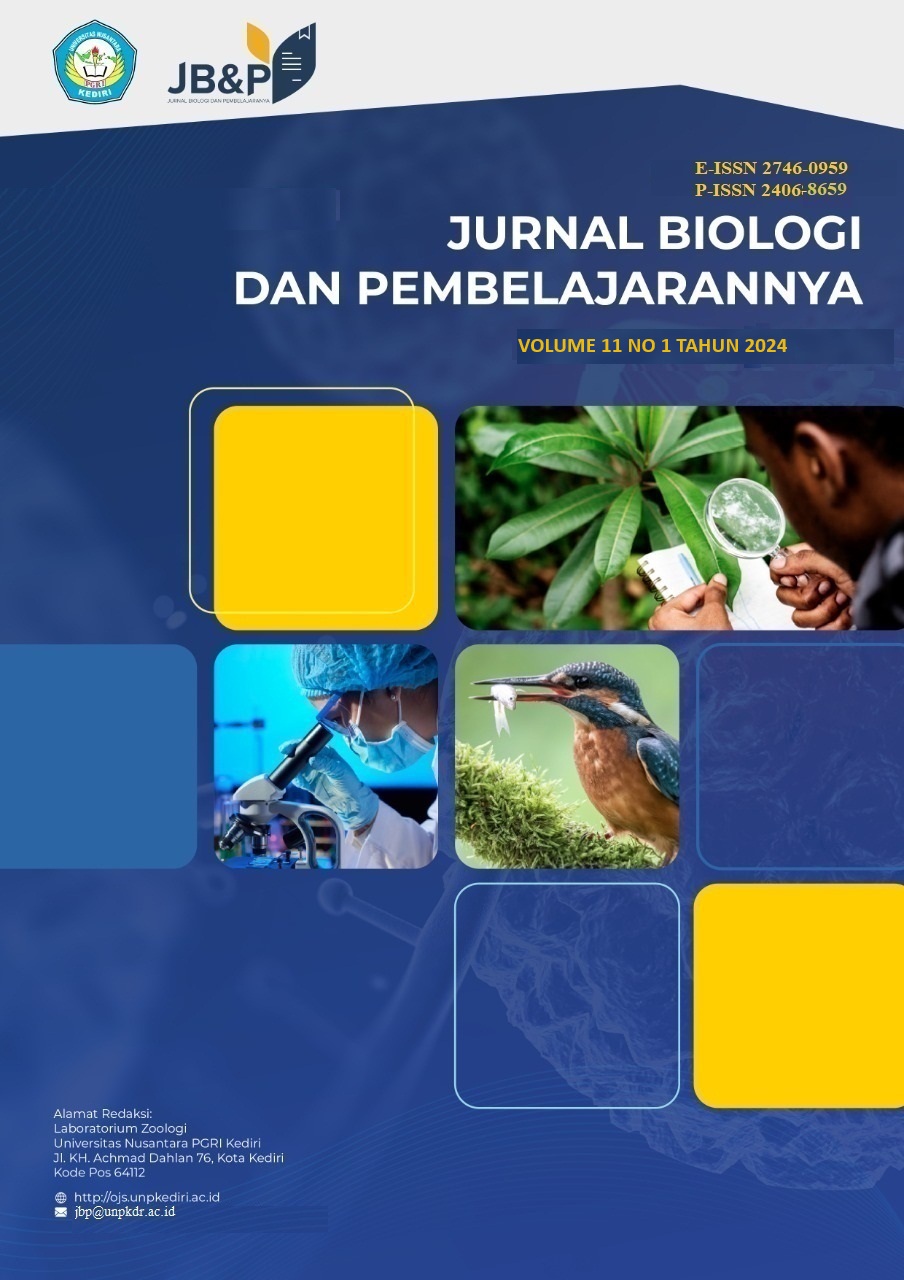Morphometric Characters Of Nile Tilapia (Oreochomis niloticus ) at Fish Cultivation in Buah Jakung Village, serang district
DOI:
https://doi.org/10.29407/jbp.v11i1.22007Keywords:
tilapia, morphomeric, meristic, habitatAbstract
Tilapia (Oreochromis niloticus), also known as tilapia or tilapia, is one of the economically important freshwater fish that was introduced to some parts of Asia, including Indonesia. Morphological features include morphometric and meristic studies of fish. Morphometrics are characteristics related to body size while meristic measurements are part of the standard measurements used in fish. The method used in this study is a qualitative method, aiming to determine the morphological characteristics of tilapia. Observations were made based on total length (Tl), head length (HL), standard length (SL), head height, fork length (FL), body height, interorbital distance, eye diameter, mouth opening width, dorsal height, maxillary length, length mandible, operculum length, prepectoral length, predorsal length.
References
Affandi R, Sjafei DS, Rahardjo MF, Sulistiono. (1992). Ikhtiologi. A Laboratory Work Guidelines. Department of Education and Culture. Directorate General of Higher Education. Inter-University Center for Life Sciences. Dalam: Maulana, R., & Isti’anah, I. (2020). Karakterisasi Morfologis Ikan Tongkol Komo (Euthynnus Affinis) Yang Didaratkan Di Pasar Ikan Kabupaten Maluku Tenggara Dan Kota Tual. Prosiding Seminar Nasional Biotik.
Andriani, Y. (2018). Budidaya Ikan Nila. Yogyakarta: Deepublish
Akmal, Y., C. M. S. Devi., Muliari., R. Humairani., & I. Zulfahmi. (2021). Morfometrik Sistem Pencernaan Ikan Nila (Oreochromis niloticus) yang Dipapar Limbah Cair Kelapa Sawit. Jurnal Galung Tropika, 10 (1), 68 – 81.
Basyar, A., Supramono A., dan Imanto, T. (2012). Laporan perekayasaan tahun 2012 BBPBAP Jepara. Kementrian Kelautan dan Perikanan Direktorat Jendral Perikanan Budidaya BBPBAP Jepara.
Ghanbarifardi, M., Aliabadian, M., & Esmaeili, H. R. (2018). Phylogeography of Waltons Mudskipper, Periophthalmus waltoni Koumans, 1941 (Perciformes: Gobiidae), from the Persian Gulfand Gulf of Oman. Zoology in the Middle East, 64(3), 207–218. https://doi.org/10.1080/09397140.2018.1470300
Ghufron, M dan H. K. Kordi. (2010). Buku Pintar Pemeliharaan 14 Ikan Air Tawar Ekonomis di Keramba Jaring Apung. Yogyakarta : Lily Publisher.
Hasan., N. Afifa., I. Maulana., S. Wahyuni., Novita., D. Anugrah., Fitri., Hafza., Naharia. Y. Sahodding., A. Rifai., Hartono., Aminullah., & Elihami. (2020). Budidaya Ikan Nila Pada Kolam Tanah. Maspul Journal of Community Empowerment, 1 (2), 24 – 33.
Hidayah, A. M., P. Purwanto., & T. R. Soeprobowati. (2014). Biokonsentrasi faktor logam berat Pb, Cd, Cr dan Cu pada ikan nila (Oreochromis niloticus Linn.) di karamba Danau Rawa Pening. Bioma: Berkala Ilmiah Biologi, 16 (1), 1 – 9.
Harahap, D. N. S., Setiawan, F., Waluyo, N. A., & Samitra, D. (2020). Keanekaragaman Ikan Air Tawar di Bendungan Watervang Kota Lubuklinggau. JB&P: Jurnla Bilogi dan Pembelajarannya, 7 (1), 23-27. https://doi.org/10.29407/jbp.v7i1.14804
Lasena, A., Nasriana., & Irdja, A. M. (2017). Pengaruh Dosis Pakan yang Dicampur Probiotik terhadap Pertumbuhan dan Kelangsungan Hidup Benih Ikan Nila (Oreochromis Niloticus). Jurnal Ilmiah Media Publikasi Ilmu Pengetahuan dan Teknologi, 6(2) : 65-76
Umami, M. (2022). Karakteristik Morfologi Ikan Gelodok (Periophthalmus chrysospilos) di Area Hutan Mangrove Mundu, Kabupaten Cirebon. JB&P: Jurnla Bilogi dan Pembelajarannya, 9(1), 48-54. https://doi.org/10.29407/jbp.v9i1.17783
Yue, G. H., Lin, H., & Li, J. (2016). Tilapia is the Fish for Next - Generation Aquaculture. International Journal of Marine Science and Ocean Technology (IJMO), 3(1), 11-13.
Zulfahmi, I., & Y. Akmal. (2020). Ekotoksikologi Akuatik. Bogor: IPB Press.
Downloads
Published
Issue
Section
License
Authors who publish with this journal agree to the following terms:
- Copyright on any article is retained by the author(s).
- The author grants the journal, right of first publication with the work simultaneously licensed under a Creative Commons Attribution License that allows others to share the work with an acknowledgment of the work’s authorship and initial publication in this journal.
- Authors are able to enter into separate, additional contractual arrangements for the non-exclusive distribution of the journal’s published version of the work (e.g., post it to an institutional repository or publish it in a book), with an acknowledgment of its initial publication in this journal.
- Authors are permitted and encouraged to post their work online (e.g., in institutional repositories or on their website) prior to and during the submission process, as it can lead to productive exchanges, as well as earlier and greater citation of published work.
- The article and any associated published material is distributed under the Creative Commons Attribution-ShareAlike 4.0 International License













